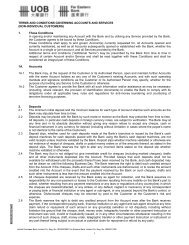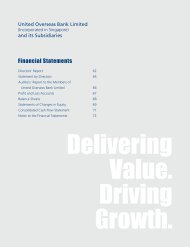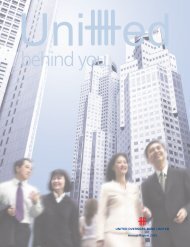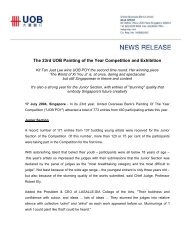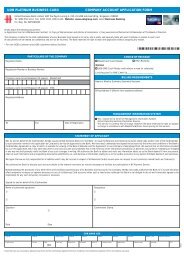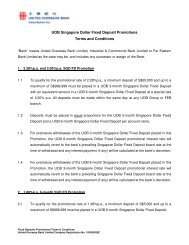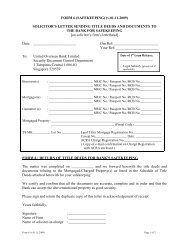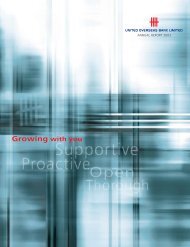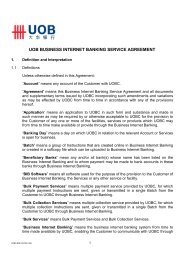Investor Roadshow - United Overseas Bank
Investor Roadshow - United Overseas Bank
Investor Roadshow - United Overseas Bank
You also want an ePaper? Increase the reach of your titles
YUMPU automatically turns print PDFs into web optimized ePapers that Google loves.
UOB Group<br />
Strength and resilience within a challenging<br />
market environment<br />
<strong>Investor</strong> <strong>Roadshow</strong><br />
March 2009<br />
Disclaimer : This material that follows is a presentation of general background information about the <strong>Bank</strong>’s activities current at<br />
the date of the presentation. It is information given in summary form and does not purport to be complete. It is not to be relied<br />
upon as advice to investors or potential investors and does not take into account the investment objectives, financial situation or<br />
needs of any particular investor. This material should be considered with professional advice when deciding if an investment is<br />
appropriate. UOB <strong>Bank</strong> accepts no liability whatsoever with respect to the use of this document or its content.<br />
1<br />
Singapore Company Reg No. 193500026Z
Agenda<br />
11<br />
Overview of UOB Group<br />
22<br />
Macroeconomic Outlook<br />
33<br />
UOB in the Challenging Environment<br />
44<br />
Growth and Regional Strategy<br />
55<br />
Conclusion<br />
2
UOB Overview<br />
Founding<br />
Founded in August 1935 by a group of<br />
Chinese businessmen and Datuk Wee<br />
Kheng Chiang, grandfather of the present<br />
UOB Group CEO, Mr. Wee Ee Cheong<br />
Expansion<br />
UOB has grown over the decades through<br />
organic means and a series of acquisitions.<br />
It is today a leading bank in Singapore with<br />
an established presence in the ASEAN<br />
region. The Group has a total network of<br />
over 500 offices in 18 countries and<br />
territories<br />
Key Statistics<br />
Total assets : S$182.9 billion<br />
(US$127.9 billion)<br />
Shareholder’s equity : S$15.6 billion<br />
(US$10.9 billion)<br />
Gross loans : S$102.0 billion<br />
(US$71.3 billion)<br />
Customer deposits : S$118.2 billion<br />
(US$82.7 billion)<br />
ROAA : 1.07%<br />
ROAE (1) : 12.2%<br />
NIM : 2.27%<br />
Non-interest / : 31.9%<br />
Total income<br />
Cost / Income : 39.0%<br />
Tier 1 CAR : 10.9%<br />
Total CAR : 15.3%<br />
Moody’s : Aa1 LT <strong>Bank</strong> Deposits<br />
S&P’s : A+ LT Issuer Credit<br />
Note: Financial statistics as at 31 December 2008. US dollar equivalent uses exchange rate of USD:SGD 1.4301 as at 31 December 2008.<br />
(1) Calculated based on profit attributable to equity holders of the bank net of subsidiary preference share dividends.<br />
3
Proven Track Record of Execution<br />
Profit (S$ million)<br />
Acquired<br />
Buana in 2005<br />
Acquired BOA<br />
in 2004<br />
2007: S$2,109m<br />
2008: S$1,937m<br />
2005: S$1,709m<br />
Acquired ICB<br />
in 1987<br />
Acquired OUB<br />
in 2001<br />
2004:S$1,452m<br />
Acquired FEB<br />
in 1984<br />
1995:S$633m<br />
2000:S$913m<br />
Acquired LWB<br />
in 1973<br />
Acquired CKB<br />
in 1971<br />
1980:S$92m<br />
1985:S$99m<br />
1990:S$226m<br />
Acquired<br />
UOBR and<br />
UOBP in 1999<br />
1935 1945 1955 1965 1975 1985 1995 2005 2010<br />
4
Sustainable Profit Contribution from <strong>Overseas</strong><br />
Operating Profit by Geography<br />
2008<br />
(in S$ million)<br />
3,200<br />
Singapore : 70%<br />
2,032<br />
145<br />
318<br />
46<br />
2,488<br />
2,337<br />
163<br />
41<br />
216<br />
427 615<br />
59<br />
2,854<br />
313<br />
627<br />
78<br />
301<br />
619<br />
49<br />
(2)<br />
Malaysia : 10%<br />
Thailand : 5%<br />
Indonesia : 4%<br />
Greater China : 2%<br />
Other : 9%<br />
1,523<br />
(1)<br />
1,706<br />
1,598<br />
(1)<br />
1,834<br />
2,230<br />
2007<br />
Singapore : 64%<br />
Malaysia : 13%<br />
Thailand : 5%<br />
2004 2005 2006 2007 2008<br />
Singapore Key ASEAN Greater China Rest of World<br />
Indonesia : 5%<br />
Greater China : 3%<br />
Note: Before amortisation of intangible assets and impairment charges.<br />
(1) Excluding one-time income.<br />
(2) Excluding the revaluation loss on the USD capital, the operating profit would be $90m.<br />
Other : 10%<br />
UOB has continued its strong performance among its country footholds in in the region<br />
5
Consistently Strong Financial Performance<br />
Net Interest Income and Net Interest Margin<br />
Net Profit After Tax<br />
(in S$ million)<br />
3.01% 3.18% 3.25% 3.21% 3.09%<br />
(in S$ million)<br />
1,452 1,709<br />
2,570 2,109 1,937<br />
2.10% 1.99% 1.99% 2.04% 2.27%<br />
2004 2005 2006 2007 2008<br />
0.78% 0.58% 0.66% 0.56%<br />
0.93%<br />
3,576<br />
Return on Average Assets<br />
2,155<br />
2,348<br />
2,710<br />
2,980<br />
(in %)<br />
1.19 1.25 1.65 1.24 1.07<br />
2004 2005 2006 2007 2008<br />
Return on Average Equity<br />
2004 2005 2006 2007 2008<br />
Net Interest Income ($m) Net Interest Margin (%)<br />
Loan Margin (%) Interbank / Securities Margin (%)<br />
(in %)<br />
10.8 12.4<br />
17.0<br />
12.6 12.2<br />
2004 2005 2006 2007 2008<br />
UOB has consistently demonstrated strong profitability<br />
6
Diversified Non-Interest Income<br />
Non-Interest Income (Non-NII) and Non-NII Ratio<br />
Non-Interest Income Breakdown<br />
(in S$ million)<br />
33.9%<br />
21.7%<br />
706<br />
398<br />
37.6% 35.8%<br />
23.9% 23.7%<br />
1,003<br />
900<br />
514 511<br />
38.8%<br />
26.2%<br />
1,278<br />
614<br />
31.9%<br />
20.8%<br />
1,095<br />
580<br />
Credit Cards<br />
11%<br />
Trade-Related<br />
12%<br />
Other fee &<br />
commission<br />
3%<br />
Investment-<br />
Related<br />
7%<br />
Trading &<br />
investment<br />
income<br />
14%<br />
Futures<br />
broking<br />
2%<br />
Other income<br />
11%<br />
Dividend /<br />
Rental<br />
10%<br />
2004 2005 2006 2007 2008<br />
Fee income ($m)<br />
Other non-interest income ($m)<br />
Fee income / Total Income Ratio (%) Non-NII / Total Income Ratio (%)<br />
Loan-Related<br />
15%<br />
Fund<br />
Management<br />
10%<br />
Service<br />
Charges<br />
5%<br />
UOB has continuously built its fee income capabilities in in an effort to diversify its income base and<br />
enhance profitability levels<br />
7
Disciplined Cost Management<br />
Operating Expenses and Expense / Income Ratio<br />
(in S$ million)<br />
(in S$ million)<br />
37.6% 37.9%<br />
41.1% 41.4%<br />
39.0%<br />
43.6%<br />
39.2%<br />
36.4%<br />
41.6% 39.4%<br />
2,018 2,050<br />
1,227<br />
188<br />
1,424<br />
222<br />
1,736<br />
256<br />
272 285<br />
556<br />
67<br />
496 518 504 532<br />
67 71 71<br />
76<br />
2004 2005 2006 2007 2008<br />
4Q 07 1Q 08 2Q 08 3Q 08 4Q 08<br />
Operating Expenses ($m)<br />
IT Expenses ($m)<br />
Expense / Income ratio (%)<br />
UOB has remained disciplined in in managing its costs<br />
8
Well-Diversified Loan Portfolio<br />
Gross Customer Loans Breakdown<br />
Net Customer Loans / Loans-Deposits Ratio<br />
(in S$ million)<br />
Transportation /<br />
Storage /<br />
Communication<br />
6%<br />
Manufacturing<br />
10%<br />
Other<br />
7%<br />
Housing Loans<br />
23%<br />
81.4%<br />
64,300<br />
78.5% 80.5%<br />
67,142<br />
76,875<br />
86.6%<br />
92,669<br />
84.5%<br />
99,840<br />
Building /<br />
Construction<br />
12%<br />
Financial<br />
Institutions<br />
16%<br />
General<br />
Commerce<br />
13%<br />
Professional &<br />
Private<br />
Individuals<br />
13%<br />
Total: S$102,033 million<br />
2004 2005 2006 2007 2008<br />
Net Customer Loans ($m) Loans-Deposits Ratio (%)<br />
UOB has a well-diversified portfolio and has consistently grown its loan base over the years<br />
9
Conservative Provisioning<br />
Non-Performing Loans (NPLs) (1)<br />
Impairment Charges on Loans<br />
(in S$ million)<br />
(in S$ million)<br />
8.0%<br />
5,484<br />
5.6%<br />
3,931<br />
4.0%<br />
3,165<br />
1.8% 2.0%<br />
36 bps<br />
235<br />
31 bps<br />
215<br />
19 bps<br />
142<br />
47 bps<br />
18 bps 33 bps<br />
324<br />
155<br />
1,713 2,062<br />
2004 2005 2006 2007 2008<br />
2004 2005 2006 2007 2008<br />
(1) Excluding debt securities<br />
NPL ($m) NPL Ratio (%)<br />
Individual impairment charges on loans / average<br />
gross customer loans (basis points)<br />
Total impairment charges on loans / average gross<br />
customer loans (basis points)<br />
UOB’s strong risk management framework and adoption of prudent provisioning policies have<br />
contributed to sound asset quality and adequate impairment coverage<br />
10
High Dividend Rate While Maintaining Robust<br />
Capitalization Levels<br />
Capital Adequacy Ratio (CAR)<br />
Net Dividend Rate<br />
(in %)<br />
(in cents)<br />
15.6<br />
16.1 16.3<br />
14.5<br />
15.3<br />
22.8<br />
24.2 12.3<br />
32.0 32.0<br />
41.0<br />
45.0 40.0<br />
11.0<br />
11.0 11.0<br />
10.0<br />
10.9<br />
16.0 16.0 16.0 16.4 20.0<br />
(1)<br />
2004 2005 2006 2007 2008<br />
Interim Final Dividend in Specie Special<br />
Dec-04 Dec-05 Dec-06 Dec-07 Dec-08<br />
Tier I CAR<br />
Total CAR<br />
(1)<br />
Dividend<br />
Payout<br />
Ratio<br />
51%<br />
64% 48% 53% 47%<br />
(1) Computed based on Basel II framework in accordance with the revised MAS Notice 637<br />
with effect from January 2008.<br />
(1) Dividend in specie of shares in <strong>United</strong> <strong>Overseas</strong> Land Limited.<br />
UOB has consistently maintained robust capitalization levels and high dividend payout<br />
11
Awards and Accolades<br />
“Best Domestic <strong>Bank</strong>”<br />
“Best Local Cash Management<br />
<strong>Bank</strong>”<br />
“Best Local Currency Cash<br />
Management Services”<br />
“Grand Prix for Best Overall<br />
<strong>Investor</strong> Relations – Large<br />
Cap”<br />
“Best SME <strong>Bank</strong> in Asia<br />
Pacific”<br />
2008<br />
2008<br />
2007<br />
“Best Local Private <strong>Bank</strong><br />
– Singapore (2 nd )”<br />
“Top 10 Best Managed<br />
Companies – Singapore”<br />
“Top 10 Best <strong>Investor</strong><br />
Relations – Singapore”<br />
“Most Valuable Singapore<br />
Brand – 2 nd position”<br />
2007<br />
2006<br />
2003, 2004, 2005, 2006<br />
UOB’s strong financial performance and regional reputation continues to receive strong endorsements<br />
locally and overseas garnering numerous accolades from leading publications, trade organizations and<br />
the investment community<br />
12
Agenda<br />
11<br />
Overview of UOB Group<br />
22<br />
Macroeconomic Outlook<br />
33<br />
UOB in the Challenging Environment<br />
44<br />
Growth and Regional Strategy<br />
55<br />
Conclusion<br />
13
Challenging Singapore Outlook<br />
As a key Asian financial services hub, Singapore has continued to attract a multitude of global multinational banks and corporations, thereby contributing to<br />
significant economic progress over the recent years<br />
In light of the current global market environment, however, the outlook for Singapore in the near-term is expected to considerably weaken<br />
Consumer and corporate spending is expected to decline in 2009 contributing to slower domestic demand<br />
Unemployment, retrenchment concerns and a declining population weigh down their impact on domestic consumption<br />
Nevertheless, the Singapore government has taken a proactive stance in combating a weakened short-term economic outlook<br />
Singapore’s structural social safety-nets such as the mandatory social security / savings system (CPF) ensures a high national savings rate<br />
Able to prudently increase national spending, incurring a budget deficit to meet the challenges of the economic downturn by drawing on the country’s<br />
substantial national reserves<br />
(in %)<br />
7.3 8.2 7.7<br />
Leadership in ASEAN albeit challenging near-term prospects<br />
Weak GDP Outlook<br />
1.2<br />
3.0<br />
(in %)<br />
3.1<br />
Unemployment Concerns<br />
2.7<br />
2.1 2.3<br />
4.4 4.2<br />
-4.0<br />
2005 2006 2007 2008 2009E 2010E<br />
2005 2006 2007 2008 2009E 2010E<br />
Government Fiscal Position as a % of GDP<br />
High Aggregate National Savings Rate<br />
(in %)<br />
0.6<br />
3.4<br />
0.8<br />
(in %)<br />
38.5<br />
41.8<br />
46.8<br />
41.8 39.6 41.2<br />
-0.3<br />
-4.1 -4.0<br />
2005 2006 2007 2008 2009E 2010E<br />
2005 2006 2007 2008 2009E 2010E<br />
Near term prospects for Singapore remain challenging given the difficult market environment. However,<br />
social safety-nets ensure that Singapore will have the capacity to withstand these problems<br />
Source: EDP, Monetary Authority of Singapore, Economic Intelligence Unit, Wall Street Research.<br />
14
South East Asia: Resilient Macroeconomic Factors<br />
UOB’s Southeast Asian country pillars’ growth and economic prospects<br />
remain stable despite the slowing US and European economies<br />
Economic fundamentals across the region remain weak in the short-term;<br />
however, weakening in UOB’s Southeast Asian pillars are not expected<br />
to worsen to the 1997 Asian financial crisis levels<br />
<br />
<br />
Resilient Markets Improved Macroeconomic Balance from 1997<br />
Levels<br />
GDP outlook, while weak in the near term, is expected to remain<br />
stable in the long term across all economies<br />
Increasing current account balance and foreign exchange reserves<br />
and lowering leverage have strengthened the economies<br />
Southeast Asia is more insulated against the structural problems faced by<br />
the open global economies due to the lower levels of involvement in<br />
complex financial products<br />
Current Account<br />
(as a % of GDP)<br />
FX Reserves<br />
(in US$ bn)<br />
1993 - 1996 2008 1993 - 1996 2008<br />
Singapore 15.6 13.5 77.0 174.2<br />
Malaysia (4.2) 10.8 27.7 91.1<br />
Thailand (8.3) (0.1) 38.7 111.0<br />
Indonesia (3.8) 0.4 10.7 53.6<br />
Total Lending as % of GDP<br />
Total Debt as % of GDP (1)<br />
(in %)<br />
158%<br />
147%<br />
134%<br />
190% 191%<br />
126%<br />
131% 107%<br />
99%<br />
61%<br />
35%<br />
36%<br />
(in %)<br />
16%<br />
12% 14%<br />
73%<br />
57%<br />
47%<br />
29% 32%<br />
26% 23%<br />
29%<br />
22%<br />
Singapore Malaysia Thailand Indonesia<br />
1997 2007 2008E<br />
Singapore Malaysia Thailand Indonesia<br />
1997 2007 2008E<br />
Southeast Asia fundamentals support resilient markets and business activity in in the region<br />
Source: Economic Intelligence Unit, Reuters, Bloomberg, Moody’s, S&P, IMF and CEIC.<br />
Note: (1) Refers to external debt as a percentage of GDP.<br />
15
South East Asia <strong>Bank</strong>ing Sector: Stronger<br />
Fundamentals although Facing Headwinds in the Nearterm<br />
Stronger <strong>Bank</strong>ing Indicators<br />
Key structural issues related to weak financial systems and poor<br />
governance have been addressed<br />
Analysts estimate that while the environment will be challenging in<br />
the near term, it will not be as severe as the 1997 Asian financial<br />
crisis<br />
Asset quality deterioration and adequate provisioning remain the main<br />
concerns for the banking sector on the back of slower loan growth<br />
<strong>Bank</strong>s are proactively looking to pre-emptively raise core capital to<br />
withstand current challenging market conditions<br />
<br />
<strong>Bank</strong>s with robust capitalization are likewise seen to take advantage<br />
of potential strategic opportunities due to the market dislocation<br />
Total Equity / Total Asset<br />
Near-term Concerns on Asset Quality<br />
(Net NPLs, in %)<br />
7.9 7.8<br />
7.2<br />
7.2<br />
4.5 4.9<br />
5.0<br />
4.2 4.1<br />
3.3<br />
1.5 1.6<br />
Singapore Malaysia Thailand Indonesia<br />
2007 2008E 2009E<br />
Preserving Capital Positions<br />
(in %)<br />
(Total CAR, in %)<br />
7.1<br />
7.7 8.2<br />
7.4<br />
9.5<br />
9.3<br />
11.4<br />
10.6<br />
14.8<br />
13.5 13.2 12.6<br />
14.9<br />
14.0<br />
19.3<br />
16.8<br />
Singapore Malaysia Thailand Indonesia<br />
Singapore Malaysia Thailand Indonesia<br />
2007 2008E<br />
2007 2008E<br />
Source: Monetary Authority of Singapore, <strong>Bank</strong> Negara Malaysia, <strong>Bank</strong> Indonesia and <strong>Bank</strong> of Thailand.<br />
Note: Singapore bank ratios based on ratios of domestic banking units. Malaysia, Thailand and Indonesia ratios based on commercial banks ratios. NPL ratio in 2008 and<br />
16 2009 based on research estimates. Capital ratio for Singapore in 2008 estimated based on the average total capital ratio of DBS, UOB and OCBC.
Agenda<br />
11<br />
Overview of UOB Group<br />
22<br />
Macroeconomic Outlook<br />
33<br />
UOB in the Challenging Environment<br />
44<br />
Growth and Regional Strategy<br />
55<br />
Conclusion<br />
17
One of the World’s Leading Credits and Well-<br />
Capitalized <strong>Bank</strong>s<br />
Total Capital Adequacy Ratio (CAR) and Tier 1 CAR (1)<br />
15.3% 15.7% 14.7%<br />
10.9% 11.9%<br />
10.8%<br />
13.0% 12.2% 11.4%<br />
9.2% 10.1%<br />
8.3%<br />
UOB Citi JPMorgan <strong>Bank</strong> of America Deutsche HSBC<br />
Total CAR<br />
Tier 1 CAR<br />
Market Capitalization, Total Equity / Total Asset and Capital Raised (2)<br />
(in US$ billion)<br />
Market cap<br />
(4 Mar 2008)<br />
Market cap<br />
(4 Mar 2009)<br />
48.8%<br />
94.4%<br />
45.7%<br />
172.3<br />
86.8%<br />
66.7%<br />
133.1<br />
115.1<br />
72.3<br />
44.7<br />
17.6<br />
22.7<br />
9.0 6.4<br />
14.9<br />
128.7<br />
46.6%<br />
68.7<br />
UOB Citi JPMorgan <strong>Bank</strong> of America Deutsche HSBC<br />
Total Equity /<br />
Total Asset 8.5%<br />
6.6%<br />
7.7%<br />
8.9%<br />
1.4%<br />
3.7%<br />
Capital Raised<br />
US$0.9bn<br />
US$109.2bn<br />
US$44.7bn<br />
US$78.5bn<br />
UOB’s capitalization levels and relative market value are at at par with renowned banks globally<br />
Source: Latest company financials, Bloomberg. Percentages refer to the percentage decline in market cap.<br />
Note: (1) Tier 1 CAR and Total CAR as of 31 December 2008.<br />
18 (2) Market capitalization in US dollars. For non-US banks, uses exchange rate of USD:SGD 1.5478 as at 4 March 2009.<br />
US$5.8bn<br />
US$23.0bn
Sound Balance Sheet Position<br />
<br />
Stable & diversified customer loans portfolio (55% of assets or S$100 billion)<br />
• Spread out across countries, business segments and industries. Portfolio diversity remained<br />
stable<br />
• Credit quality intact with no major signs of deterioration. Maintain prudent approach<br />
• Diversification strategy continues<br />
<br />
Sound & diversified investment portfolio (14% of assets or S$26 billion)<br />
• 40% in government securities, mainly in Singapore<br />
• Remaining mainly investment-grade bonds (>75%). No concentration, performing. Held for longterm<br />
• Minimal exposure to CDOs and ‘structured’ assets<br />
<br />
Strong liquidity management<br />
• Loans-to-deposits ratio improved to 84.5%<br />
• Customer deposits up 10%; accounts for 81% of deposits from 77% in Dec 2007<br />
Proven track record of conservative balance sheet management<br />
19
Strong Capital Position to Withstand Current<br />
Challenging Environment<br />
<br />
<br />
<br />
<br />
<br />
Strengthened capital position with $1.32 billion preference share issue<br />
Strong CAR at 10.9% for Tier 1 & 15.3% for Total CAR - well above regulatory requirements<br />
Current capital level able to withstand near-term potential shocks and portfolio deterioration<br />
Continue to stress-test portfolios and review our capital needs. Have flexibility in our options<br />
Growing selectively to preserve capital<br />
20
The Bright Spots<br />
<br />
<br />
<br />
<br />
<br />
Asian economies more resilient and in position to rebound faster since it is less saddled with structural<br />
problems<br />
Governments in region have flexibility in providing fiscal safety nets to alleviate further shocks and<br />
stimulate economies. Strong fundamentals will continue to support domestic consumer and business<br />
activity. Singapore’s risk-sharing schemes also provide buffer and business opportunities<br />
Benign competitive landscape expected as foreign banks face higher funding costs and capital<br />
constraints. Re-intermediation opportunities among corporates expected to surface given a tight<br />
liquidity environment<br />
Return to ‘basics’ banking model bodes well for UOB – increasing pricing power, returning to<br />
traditional loan facilities<br />
Able to build competitive advantage through ongoing investments as banks focus on deleveraging and<br />
repairing balance sheets<br />
UOB is is well-positioned to take advantage of opportunities within the challenging market environment<br />
21
Agenda<br />
11<br />
Overview of UOB Group<br />
22<br />
Macroeconomic Outlook<br />
33<br />
UOB in the Challenging Environment<br />
44<br />
Growth and Regional Strategy<br />
55<br />
Conclusion<br />
22
Strategic Focus<br />
Information<br />
Technology<br />
Risk<br />
Management<br />
&<br />
Compliance<br />
Investment<br />
<strong>Bank</strong>ing<br />
Consumers<br />
SMEs<br />
Treasury<br />
Operational<br />
Excellence<br />
Human<br />
Resources<br />
To be recognized as a leader in in consumer and SME banking services in in the region with investment<br />
banking and treasury products in in support<br />
23
Strategic Directions<br />
Strengthen Domestic Market<br />
Leadership in Core Segments<br />
Further Grow Established<br />
Regional Franchise<br />
Establish Strategic Partnerships –<br />
Focused in High Growth Regions<br />
Invest in Infrastructure and Talent<br />
for the Future<br />
Our Mission:<br />
To Be A Premier <strong>Bank</strong> in in the Asia-Pacific Region<br />
24
Singapore Strategy<br />
<br />
<br />
<br />
<br />
<br />
Maintaining housing loan market share in subdued environment<br />
Market leader in SME financing. Support government initiatives and remain committed to<br />
customers<br />
Opportunities in Corporate lending. Pricing power continues<br />
Asset quality intact - continued focus on quality credits and selective in portfolio management<br />
Well-positioned to seize opportunities, remain disciplined<br />
25
<strong>Overseas</strong> Strategy: Anchor Regional Franchise to<br />
Strategically Position for the Future<br />
<br />
See region as key to our future growth<br />
• Unique competitive advantages: Strong familiarity with the markets; Natural flow of<br />
customers’ regional expansions; Scalable infrastructure<br />
• Recognize potential upside in Southeast Asia<br />
<br />
<br />
<br />
<br />
Made inroads in key regional markets to understand operating environment. Then scaled<br />
up presence with majority acquisitions in banks of strategic fit<br />
Well-established regional footprint with extensive distribution networks in Malaysia,<br />
Thailand and Indonesia<br />
Ongoing investments in franchise, infrastructure and capabilities to integrate into a single<br />
regional operating platform<br />
Maintain global diversification for a balanced portfolio<br />
26
Key Markets’ Developments and Strategy<br />
<br />
Thailand – Good turnaround<br />
<br />
China – Making inroads<br />
• Strengthened balance sheet and<br />
operating platform<br />
• Pursue disciplined growth<br />
• Good progress following local<br />
incorporation<br />
• Building RMB business, establishing<br />
infrastructure<br />
• Pace growth, stay focused at high-end<br />
of market segments<br />
<br />
Malaysia – Targeted growth<br />
<br />
Indonesia – Consolidating position<br />
• Well-established history<br />
• Well-placed to grow target Consumer<br />
and SME businesses<br />
• Took majority stake in Buana for more<br />
effective strategic execution<br />
• Strengthening core franchise<br />
Strengthening franchise and capabilities for future, long-term growth<br />
27
IT Management Strategy<br />
<br />
Focus on aligning IT with the Business<br />
• Customer-centric processes<br />
• Differentiation through service and cost<br />
<br />
Create flexibility and capacity in IT infrastructure<br />
• Buy-not-build proven software packages where possible<br />
• Customer-centric & modular in architecture<br />
• Selective outsourcing to leverage external skills, resource management<br />
<br />
Consolidate for scale, time to market, risk management<br />
28
Creating Scale – Shared IT Platforms<br />
<br />
<br />
Consolidating of IT platforms across key subsidiaries since<br />
2005/06. Using technology to bring the markets closer.<br />
Significant progress made. Examples are:<br />
• Credit cards: Singapore, Thailand, Indonesia, Hong<br />
Kong<br />
• Treasury: Singapore, Thailand, Indonesia, Hong Kong,<br />
China<br />
China<br />
• Lending & Basel related: Singapore, Thailand, China<br />
<br />
<br />
<br />
• Risk & Profitability measures: Singapore, Malaysia,<br />
Thailand, China<br />
• Regional ATM network – 500 across SEA<br />
Singapore chosen to be the IT Processing Hub for the<br />
above<br />
Scale is being created; leverage on investment;<br />
standardised key control and risk processes; speed to<br />
market for product roll-out<br />
Continue to propagate other core banking systems<br />
Thailand<br />
Malaysia<br />
Singapore<br />
Indonesia<br />
29
Managing Operational Risks in the Region<br />
<br />
From a collection of banks, critical to unify operating practices – from credit, service standards,<br />
market risks and back office practices<br />
<br />
Back Office is key in delivering a regional UOB Brand of service. Align to business strategy and<br />
priority<br />
<br />
Having seen the success of sharing common IT platforms, timely to focus on opportunities to<br />
also create scale (ie. back office factories). e.g. call center, trade, etc<br />
<br />
Operating model – unify service, products, risk management, IT etc across the key markets.<br />
Scale is a long-term competitive advantage not easily duplicated<br />
<br />
Opportune time to invest in IT, process and people. To lay the operating platform for future<br />
growth<br />
30
Agenda<br />
11<br />
Overview of UOB Group<br />
22<br />
Macroeconomic Outlook<br />
33<br />
UOB in the Challenging Environment<br />
44<br />
Growth and Regional Strategy<br />
55<br />
Conclusion<br />
31
Why UOB?<br />
Southeast Asia proxy<br />
Well-anchored regional bank with more than a local knowledge - a local<br />
network within each country<br />
Strong integrated regional<br />
franchise<br />
<strong>Bank</strong>ing business:<br />
Strong basics<br />
Prudent and disciplined<br />
Franchise value to be<br />
further enhanced by<br />
Asia’s growth<br />
Operating platform, risk management, and IT anchored back to well-regulated<br />
Singapore system<br />
UOB well-positioned to ride through challenges – strong credit ratings, highlycapitalised,<br />
well-diversified portfolio, strong balance sheet and sound liquidity<br />
Continue to diversify portfolio, strengthen balance sheet, manage risks and<br />
build core franchise for the future<br />
Consistent in strategy and execution with a long-term view<br />
Conducting ongoing investments to capture region’s potential – including<br />
China, Vietnam and India<br />
Proven track record of financial conservatism and strong management committed to the long-term<br />
32




